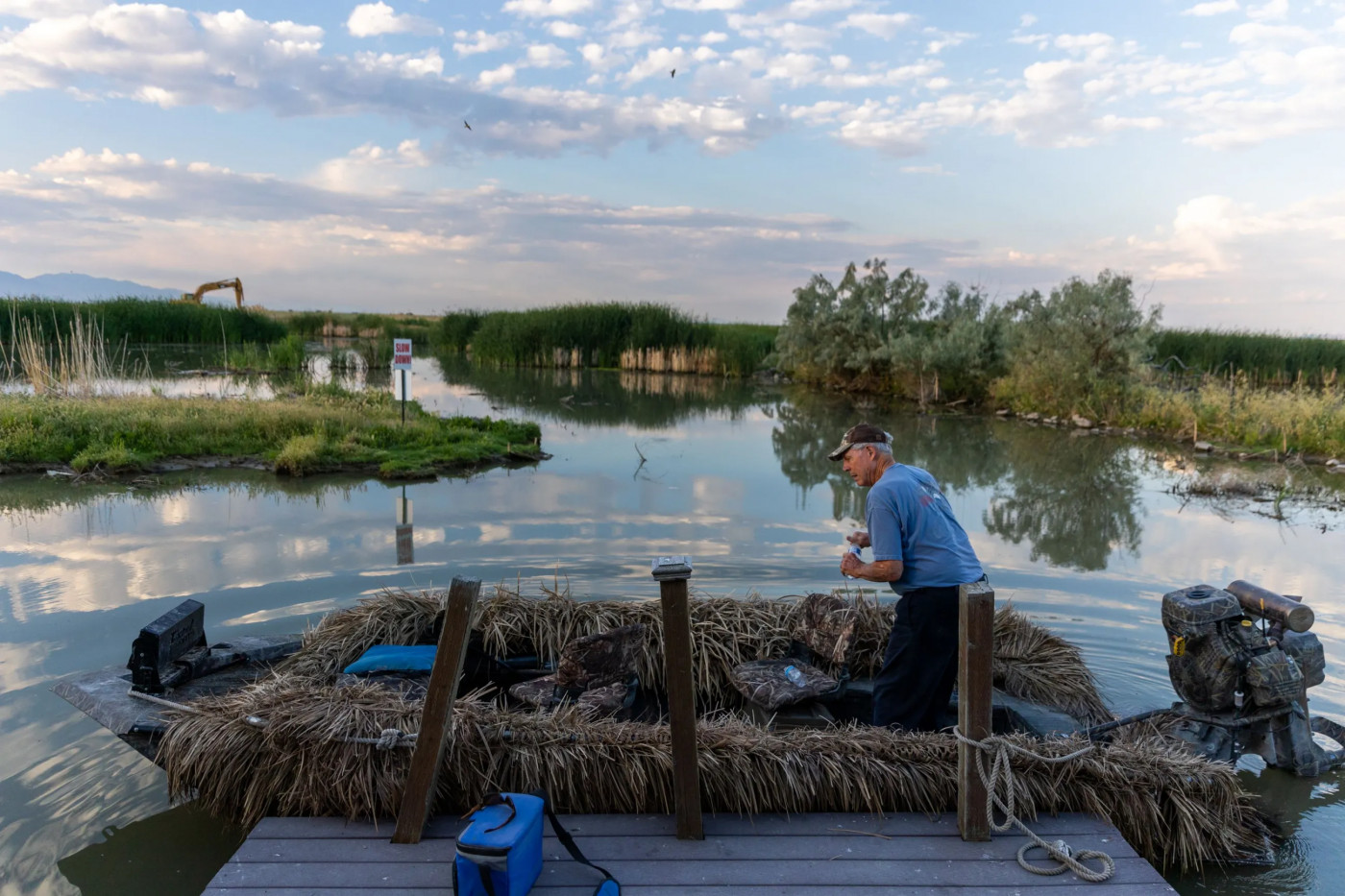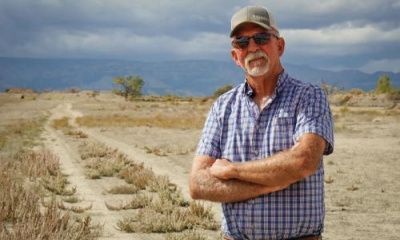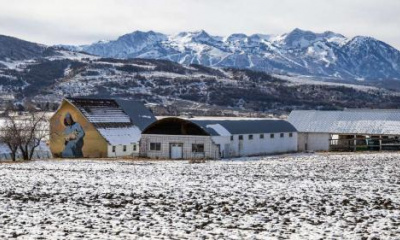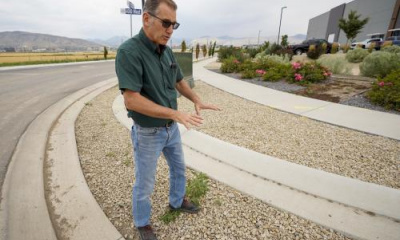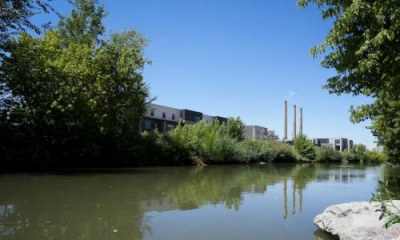Conservation of Great Salt Lake wetlands dates back to the late 1800s. Now it’s more important than ever
Hunting is about more than just killing, it is about saving.
Shortly after the Civil War, private citizens of Utah began buying up land around the shores of the Great Salt Lake to not only farm, but to protect its wetlands.
The land holdings of an estimated 40,000 acres ultimately grew into private duck clubs, of which many continue to exist today.
Back then, duck was a delicacy, and hundreds of ducks darkened the sky, with early accounts describing their sound as that of a freight train.
“Preserving the marshland was critically important, and you know at that time, the sentiment was that the only good swamp was a drained swamp, and up until a few decades ago, draining a swamp or marsh was considered a civic service, and these people were doing just the opposite,” said Jack Ray, president of the Utah Waterfowl Association.
But as the Great Salt Lake continues to shrink — it dipped to a new historic low just this summer — so do its wetlands, imperiling millions of migratory birds and other wildlife.
Wetlands, birds and Utah
The nearly 75-mile Great Salt Lake and its sprawling ecosystem supports 75% of Utah’s wetlands. It has been designated by the Western Hemisphere Shorebird Reserve Network as a site of “hemispheric importance.”
Ray said a researcher studying cases of avian botulism visited the marshes of the Great Salt Lake in the early 1900s and would go on to testify before Congress that next to the Mississippi Delta, the Great Salt Lake wetlands was the most important place in the United States for migratory birds.
“So even then, there was a recognition that the Great Salt Lake had an outsized influence on bird life in North America.”
Along with the duck clubs, Ray said Utah political leaders had the foresight for the state to begin acquiring land along the shores of the Great Salt Lake to set up wildlife management areas, with the earliest being established in the 1920s to provide public access to hunters.
“As a result of this passion for duck hunting,” Ray said more land was set aside for conservation.
Wetlands are not only important for waterfowl, wildlife and hunters. They serve as nature’s filter, siphoning off harmful nutrients and other pollutants that could otherwise reach the largest saline lake in the Western Hemisphere.
But due to drought and diversions, much of the water intended for wetlands and the Great Salt Lake is no longer there.
Even before the drought, before the Great Salt Lake entered the unlucky spotlight of being another drying saline lake, these private duck clubs, the state of Utah and organizations like Ducks Unlimited have been doing the quiet work of preserving the marshes and as a result, getting more water to the lake.
A Ducks Unlimited-led coalition recently announced the launch of a $3 million investment to improve water quality and quantity in the Great Salt Lake and Lower Bear River watershed. The effort aims to enhance or protect 7,800 acres of wetlands and grasslands in Box Elder, Davis and Weber counties on five project sites. The projects will improve the flow of water while filtering pollutants.
Chris Bonsignore, manager of conservation programs for Ducks Unlimited, said this continues efforts that have been carried out for years and helps support a $62 million annual industry for waterfowl enthusiasts.
“The Great Salt Lake and the Lower Bear River ecosystem is one of the most unique and important wetland areas in the Western Hemisphere,” he said. “Water quality concerns are increasing with declining water availability and a warming climate. This program addresses these threats and offers solutions that may be transferable to other drought-stricken areas of the West.”
Partners in progress
Ducks Unlimited teams up with private landowners like Procter & Gamble — the multinational corporation with a facility in Corinne, Box Elder County — that wanted to offset water use by improving efficiency.
That project piped open ditches, delivering more water to wetlands and to the Great Salt Lake.
Southwest of Corinne at the Chesapeake Duck Club, established in 1903, Ducks Unlimited and volunteers from the club set about wetland restoration work one early July morning.
They took to boats, surveyed nesting sites and looked for more efficient ways to move water through the marshes, and ultimately to help the ailing Great Salt Lake.
Often, the work means reconfiguring artificial changes to what once was a natural drainage system.
It involves early hours, long days, sweat, mud and bugs.
Carroll Dolson would not have it any other way. He drove 96 miles from his home in Herriman to do volunteer work at the duck club he has belonged to for 33 years.
He revels in the storied history of the club, which would provide ducks for the Chicago area back in the day.
“My grandchildren will absolutely love what we do,” he said. “We take this as absolute privilege to be able to do what we do.”
Dolson has been part of an effort that raised hundreds of thousands of dollars to benefit the wetlands.
“I’ve been very blessed. I grew up with nothing in western Nebraska.”
Now, he is staying in his “unit” at the duck club — a slick, permanent fixture on the landscape complete with air conditioning and a mini-kitchen — as he carries out his mission to protect this piece of land.
“I’m not roughing it by any means,” he said, laughing.
Dolson said duck hunting is about giving back, noting that much of society is all about the taking.
“So I think what we are concerned about is the preservation, the habitat, the healthy air, and I think it is a healthy lifestyle,” he said. “I want to leave this place better than when I found it and that’s my desire.”
Birds fly over the Chesapeake Duck Club near Corinne, Box Elder County, on Wednesday, July 13, 2022.
The struggle of birds and wetlands
Wetlands protection and restoration is not an easy task.
Drought is the enemy, drying up prime habitat for waterfowl and other wildlife, choking the flow of water to the Great Salt Lake.
As the wetlands dry, opportunistic phragmites move in, suck up precious water, and spread like a fire.
The state has an ambitious program to remove the phragmites, as do other organizations like Ducks Unlimited and The Nature Conservancy, with an assist from the federal government in grants.
But money only goes so far, and the weeds know no bounds.
“When you don’t have water in the wetlands, it can actually promote the spread of that weed, and it is a terrible weed,” Bonsignore said. “It is sort of ubiquitous around the Great Salt Lake and the wetlands in particular. And without the ability to flood these wetlands, it creates these conditions where phragmites can thrive and then we are setting the table where it even becomes worse.”
Utah’s booming growth is also putting pressure on the issue of water scarcity.
“The human population is expanding tremendously in this area and it has been for a while, and that is going to require more water to support that population and it probably means less water going to the wetlands and the lake,” Bonsignore said.
Utah, in fact, led the nation in population growth over the past decade.
And then there are the raccoons.
They, like skunks, dine on the eggs and can decimate bird populations.
One study based on a survey showed a less than 5% survival rate of nests of cinnamon teal, a rare duck that makes the Great Salt Lake area its prime breeding ground.
“Basically all their nests were being wiped out,” Ray said.
Raccoons are nonnative to Utah, are considered a nuisance, and can be trapped and killed.
But Blair Stringham, assistant section chief with the Utah Division of Wildlife Resources, said taking out raccoons is like playing a game of whack-a-mole.
“A lot of what we have seen is there is this constant source of predators coming from the urban areas like Farmington and Ogden, where they are coming just as fast as we can take them.” he said. “It’s an overwhelming problem.”
Like wetlands restoration, organizations and state and federal agencies have to be opportunistic about how they spend their dollars, and where.
“We have tried to get as many as we can during the nesting period,” he said. “It could be an ongoing, 24 hours a day, seven days a week type of thing, there are so many of them.”
The circle of life
Raccoons matter to the health of the Great Salt Lake because of the continual threat they pose to ducks and other wildlife.
If drought and predators diminish a healthy waterfowl population, what happens to wetlands conservation? What happens to a multimillion-dollar annual industry and generations of families who have sought to preserve the marshes maligned for so long?
Ray said Utah’s infusion of $40 million to promote more conservation and help the Great Salt Lake builds on efforts that have been going on for years, but highlights a new urgency, roping in the general public about a problem that hunting enthusiasts have known about for some time.
“The Legislature did some bold things back over a century ago and now the Legislature is embarking on another great thing to see that the Great Salt Lake is preserved for generations to come,” Ray said.
Nature unveiled
“Well I think a lot of people think that all we do is go out there and hunt and kill ducks,” Dolson said. “Yeah, do I do that? I absolutely do that. I love to kill a duck ... but I brought up my four grandchildren through the duck club when they first started hunting.”
Their mother died of cancer six years ago.
He brings the grandchildren up to the duck club, they go out on a boat and enjoy the marshes.
“It’s been a godsend and safe haven for our grandchildren.”
It’s a bonding hard to explain, being out in the elements, sharing a vision, enjoying what nature provides.
Ray, as president of the Utah Waterfowl Association, brings people out to the wetlands every chance he can.
He believes education and tours are key to saving them, and the Great Salt Lake.
“Almost universally I think it is a moving experience for them because they see something they may have heard about and with the wonders of the Great Salt Lake, but until they have been out there firsthand in the marshes, it is a connection they are missing out on.”
He recalls when he was a teenager going with friends to Farmington Bay.
“We would spend all day and develop this tangible connection. The day would come to a close and the sun would be setting behind Antelope Island and we’d pick up our decoys and the sky would just turn orange and the marsh was full of birds. The ducks would be whistling around you and it is something that strikes your soul,” he said. “That is something that you just don’t forget and you want it to continue on and have other people have that experience and appreciate it.”
That, Ray said, will help save the Great Salt Lake.

